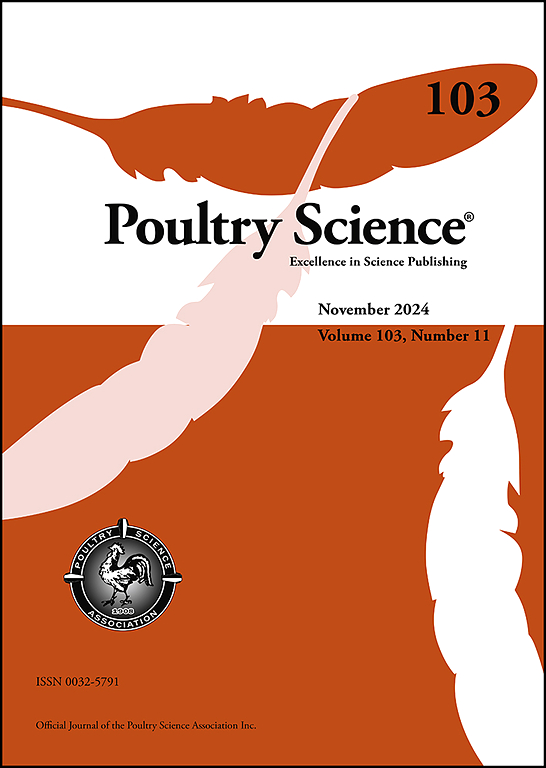一种基于纳米体的高灵敏度一步免疫分析方法,用于特异性检测鸡腺病毒血清4型抗体
IF 4.2
1区 农林科学
Q1 AGRICULTURE, DAIRY & ANIMAL SCIENCE
引用次数: 0
摘要
由禽腺病毒血清型4 (FAdV-4)引起的心包积液综合征给家禽业造成了重大的经济损失。为了监测病毒暴露和疫苗效力,已经开发了一些传统的基于抗体的免疫测定方法来检测抗fadv -4抗体。然而,这些分析有一些缺点,包括多步骤操作和较高的生产成本。近年来,纳米体被认为是一种很有前途的免疫检测工具。本研究筛选了23个抗FAdV-4的纳米体,并用辣根过氧化物酶(HRP)在HEK293T细胞中表达。然后选择FAdV-4-Nb28-HRP融合蛋白,建立竞争性酶联免疫分析法(cELISA)检测鸡血清中抗fadv -4抗体。包被抗原、融合蛋白和检测血清的最佳浓度和稀释度分别为400 ng/孔、1:80和1:20。包被板抽真空保存后,cELISA检测临床鸡血清只需一步操作,全程时间为75 min,具有较高的灵敏度、特异性、重复性,与市售ELISA试剂盒一致性好。当对攻毒鸡的序列血清进行检测时,与商用ELISA试剂盒相比,cELISA显示出更高的灵敏度。此外,表位定位显示,纳米体特异性识别纤维-1蛋白的GLN235 ASN236 SER238位点,在不同的fadv1 -4分离株中高度保守,与fadv1和-8不同。结果表明,cELISA能特异性检测抗fadv -4抗体。综上所述,所开发的一步纳米体cELISA是FAdV-4流行病学调查和疫苗免疫评价的理想方法。本文章由计算机程序翻译,如有差异,请以英文原文为准。
A highly sensitive one-step nanobody-based immunoassay to specifically detect antibodies against fowl adenovirus serotype 4
Hepatitis-hydropericardium syndrome, caused by fowl adenovirus serotype 4 (FAdV-4), has resulted in significant economic damage to the poultry industry. To monitor viral exposure and vaccine efficacy, some traditional antibody-based immunoassays have been developed for detecting anti-FAdV-4 antibodies. However, these assays have some drawbacks including multi-step operations and higher production cost. Recently, nanobodies are regarded as a promising tool for developing immunoassays. In the study, 23 nanobodies against FAdV-4 were screened and expressed with horseradish peroxidase (HRP) in the HEK293T cells. Then, the FAdV-4-Nb28-HRP fusion protein was selected for developing competitive enzyme-linked immunoassays (cELISA) to detect anti-FAdV-4 antibodies in the chicken sera. The optimal concentrations and dilutions for the coating antigen, fusion protein and testing sera were determined to be 400 ng/well, 1:80 and 1:20, respectively. After the coated plates were vacuumized and stored, the operation of cELISA to detect clinical chicken sera was only one-step and the full time was 75 min. The cELISA also exhibited high sensitivity, specificity, reproducibility and good agreement with the commercial ELISA kit. When the sequential sera from the challenged chickens were tested, the cELISA showed superior sensitivity compared with the commercial ELISA kit. Moreover, epitope mapping revealed that the nanobody specifically recognized the sites GLN235 ASN236 SER238 of the fiber-1 protein, highly conserved among different FAdV-4 isolates and different from the FAdV-1 and -8. The results indicated that cELISA can specifically detect anti-FAdV-4 antibodies. Collectively, the developed one-step nanobody-based cELISA is an ideal method for epidemiological investigation and vaccine immune evaluation of FAdV-4.
求助全文
通过发布文献求助,成功后即可免费获取论文全文。
去求助
来源期刊

Poultry Science
农林科学-奶制品与动物科学
CiteScore
7.60
自引率
15.90%
发文量
0
审稿时长
94 days
期刊介绍:
First self-published in 1921, Poultry Science is an internationally renowned monthly journal, known as the authoritative source for a broad range of poultry information and high-caliber research. The journal plays a pivotal role in the dissemination of preeminent poultry-related knowledge across all disciplines. As of January 2020, Poultry Science will become an Open Access journal with no subscription charges, meaning authors who publish here can make their research immediately, permanently, and freely accessible worldwide while retaining copyright to their work. Papers submitted for publication after October 1, 2019 will be published as Open Access papers.
An international journal, Poultry Science publishes original papers, research notes, symposium papers, and reviews of basic science as applied to poultry. This authoritative source of poultry information is consistently ranked by ISI Impact Factor as one of the top 10 agriculture, dairy and animal science journals to deliver high-caliber research. Currently it is the highest-ranked (by Impact Factor and Eigenfactor) journal dedicated to publishing poultry research. Subject areas include breeding, genetics, education, production, management, environment, health, behavior, welfare, immunology, molecular biology, metabolism, nutrition, physiology, reproduction, processing, and products.
 求助内容:
求助内容: 应助结果提醒方式:
应助结果提醒方式:


